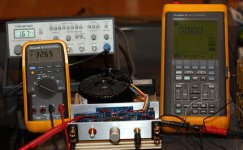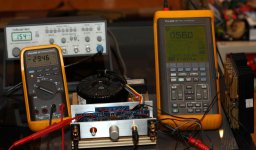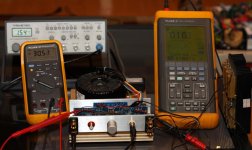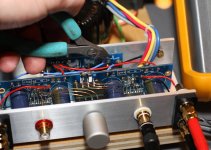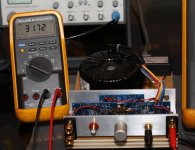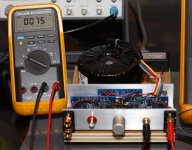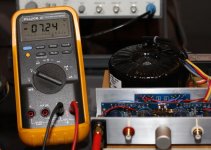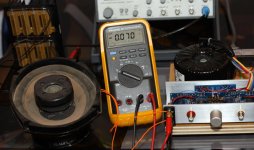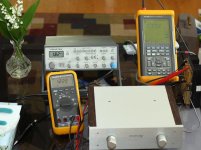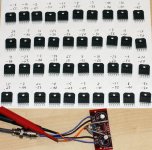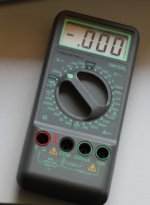After we connect the dummy load, the DC offset drops down to 75mV. In my test, it does not happen right away though, but takes approx a second or so for the voltage to drop.
I did try it with a test speaker and unfortunately the DC voltage was still present (at 24V or so)
I did try it with a test speaker and unfortunately the DC voltage was still present (at 24V or so)
Attachments
With test speaker connected, the voltage drops immediately down to 70mV and there is no danger whatsoever to the speaker.
The above findings are quite interesting and surprising. It was reported few times on a forum, that there is no danger to the speakers when one rail disappears, however, it seems like this is only the case with the positive rail. With a negative supply disconnected, I couldn't eliminate DC offset with my test speaker, although with a dummy load, the offset was going down indeed.
That Blaupunkt car speaker took 24V for at least 4 seconds many times over and still didn't suffer any damage
The above findings are quite interesting and surprising. It was reported few times on a forum, that there is no danger to the speakers when one rail disappears, however, it seems like this is only the case with the positive rail. With a negative supply disconnected, I couldn't eliminate DC offset with my test speaker, although with a dummy load, the offset was going down indeed.
That Blaupunkt car speaker took 24V for at least 4 seconds many times over and still didn't suffer any damage
Attachments
Peter Daniel said:I do the same test for 4ohm load (8 resistors in parallel) and initially we can see 56W power output with rails going down even further to 29.5V.
However, as the heatsinks warm up (and it happens really fast), the power colapses down to 10W or so. Those heatsinks are definitely not suitable for 4ohm loads under full power.
I did the same test today with amp in a proper size chassis. A single channel was driven with 100Hz sine wave into 4ohm dummy load. Just before clipping, I measured the output voltage.
Initially, the amp was producing 46W, after half an hour the power dropped to 37W (12.2 RMS voltage across the 4 ohm load). The sine wave was still reasonably clean and the chassis only moderately warm. The heatsink with power resistors (used as load) was close to 50deg in temp.
We can conclude that the amp with 2 x 22V AC transformer will produce approx 40W into both 8 ohm and 4ohm loads (as measured).
The peak power should be much higher though.
Attachments
Hi Peter,
Thank you for posting all this info!
What is your take on using/not using a Ci cap on your boards to control DC offset?
Would a potted resistor work to to decrease DC offset? and if yes , what would you use and where would it go in the signal chain?
Thank You,
Robert
p.s. just received 2 of your kits!
Thank you for posting all this info!
What is your take on using/not using a Ci cap on your boards to control DC offset?
Would a potted resistor work to to decrease DC offset? and if yes , what would you use and where would it go in the signal chain?
Thank You,
Robert
p.s. just received 2 of your kits!
rfenergy said:What is your take on using/not using a Ci cap on your boards to control DC offset?
Would a potted resistor work to to decrease DC offset? and if yes , what would you use and where would it go in the signal chain?
In real life, the offset is quite low, especially with amp connected directly to preamp stage with low impedance buffered output.
I often measure chips for offset and it's quite possible to select them for less than 5mV offset in a given configuration.
Ci cap is in a signal path, and it will influence the sound basically same way as input coupling cap. That's why I prefer not to use it.
In a minimized GC circuit, I don't see a way to adjust offset with a trimpot. Lowering the input resistance will decrease the offset, but you might not want go too low with it.
Hi Peter -
A bit off topic.
It appears a multimeter is something I don't want to be without for this project.
I've seen bad reviews on some of the cheap ones but your Fluke is out of the question for me.
There is a model # VC97 @ MultimeterWhse.com for $29.95. Could I trouble you to check it out and let me know if you think it would give accurate enough measurements for a GC?
Any other lower priced recommendations on these would be appreciated as well. Nothing in budget class at P.E. or RatShack floats my boat.
Thanks - Bluto
A bit off topic.
It appears a multimeter is something I don't want to be without for this project.
I've seen bad reviews on some of the cheap ones but your Fluke is out of the question for me.
There is a model # VC97 @ MultimeterWhse.com for $29.95. Could I trouble you to check it out and let me know if you think it would give accurate enough measurements for a GC?
Any other lower priced recommendations on these would be appreciated as well. Nothing in budget class at P.E. or RatShack floats my boat.
Thanks - Bluto
Yes, that one should work fine: http://www.multimeterwarehouse.com/vc97.htm
I quiter often use similar, cheaper meter, and it works equally well as Fluke.
I quiter often use similar, cheaper meter, and it works equally well as Fluke.
Attachments
Peter, 7/10ths -
Thanks -
Peter - I'm gona get ahead of you for a minute if you don't mind.
A few Companies offer offer kits for bass /treble controls. I've seen snippets here and there as to why you don't want such but can't recall reasoning and think this might be a good place for that info. Can you give a quick read on your thoughts here in laymans terms?
Bluto
Thanks -
Peter - I'm gona get ahead of you for a minute if you don't mind.
A few Companies offer offer kits for bass /treble controls. I've seen snippets here and there as to why you don't want such but can't recall reasoning and think this might be a good place for that info. Can you give a quick read on your thoughts here in laymans terms?
Bluto
Bluto said:
A few Companies offer offer kits for bass /treble controls. I've seen snippets here and there as to why you don't want such but can't recall reasoning and think this might be a good place for that info. Can you give a quick read on your thoughts here in laymans terms?
Hi Bluto,
His design avoids an input coupling cap, sacrifices superior DC offset performance to avoid a feedback cap, and uses smaller than speced smoothing caps on the PS.
Why would he find it acceptable to put a bunch of them in for tone control, smack dab in the signal path?
- Home
- More Vendors...
- Audio Sector
- Commercial Gainclone kit- building instructions
